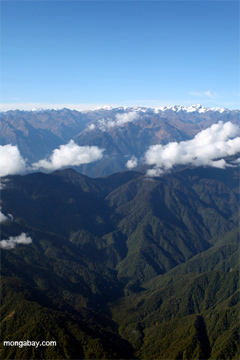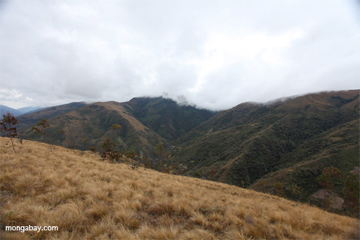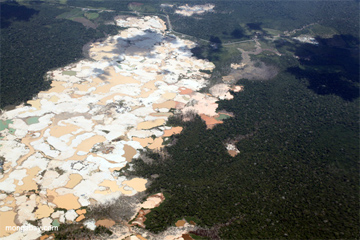Three new private conservation areas in the Amazon-Andes region of Peru will help buffer the country’s national park system while offering new opportunities for local people to benefit from protecting ecosystems.
The new private conservation areas cover 18,882 hectares (46,659 acres) of habitat ranging from high elevation grasslands to cloud forests to rainforests of the Andean foothills in the departments of Cusco and Madre de Dios. Two of the protected areas were set aside by communities: the 18,695-ha Ukumari Llaqta Private Conservation Area by the Q’eros indigenous community of Japu and the 164-ha Pumataki Private Conservation Area by the Pillco Grande community adjacent to Manu National Park. The third, the 23-ha San Juan Bautista Private Conservation Area near Tambopata Reserve, was contributed by a local family.
 Cloud forest in the Amazon slope of the Andes. Photo by Rhett Butler. |
While Pumataki and San Juan Bautista are small in extent, the reserves provide important examples of a clause in Peruvian law that allows any landowner to convert their holdings into a nature reserve. The 40-year permit for a private conservation area is renewable, enabling families and communities to leave a legacy of conservation for future generations.
The new reserves are also significant in that they are part of a broader initiative by the Amazon Conservation Association, an NGO with offices in Washington D.C. and Peru, to support sustainable livelihoods in a region that is traditionally very poor and is expected to be particularly vulnerable to the effects of climate change. For example, the community of Pillco Grande is participating in a pilot project that aims to determine how funds for compensation
for ecosystem services — like the proposed REDD+ program for conservation of forest carbon stocks — can be best and most equitably distributed to communities. The need for forest conservation in the area is high: since 2000, the annual deforestation rate in nearby cloud forests exceeded four percent per year due to clearing for cattle grazing and crops.
The Pillco Grande pilot project capitalizes on the community’s decision to leave its cloud forest standing. Community members — men and women — are paid to monitor the forest and protect against escaped agricultural fires. They are also restoring areas around the forest, planting trees as well as nitrogen-fixing beans to improve the soil and reduce the need for fertilizer and land-clearing. Community members hope their forest, which contains a wealth of Andean endemics and is called “Pumataki” for the puma that roam it, will eventually attract ecotourists drawn by the wonders of Manu.
 High elevation grasslands with Pumataki Private Conservation Area in the background. Photo by Rhett Butler.  Gold mining is a threat to Tambopata Reserve in Madre de Dios |
“Pumataki means ‘the place where puma sing,'” said Jose Luis Peña, a community member, told mongabay.com during an August 2011 visit. “There are also bears and bromeliads in forest so there are many things for tourists.”
But there are other motivations for participating in the project. The Pillco Grande community is concerned about the potential impacts of climate change, which they understand is partly driven by deforestation (they correctly noted that industrial activities in rich countries are the primary cause of rising carbon dioxide emissions). They have already observed shifts in rainfall patterns and seasonal temperatures as well as plant species creeping up valleys from the lowlands.
“Everything has totally changed,” Nieves Quispe said. “[Rainfall] is not very predictable anymore.”
“We have more crop damage,” added Battazai Quispe Curasi. “There is now a caterpillar that gets into apples, peaches, and pears.”
To see the direct ravages of deforestation, the community looks to neighboring villages that have been affected by landslides, soil erosion, and less reliable water sources.
“The forest helps the community here in Pillco Grande and it also helps the community of the entire world,” said Peña. “But we need help protecting our forest.”
Since 2009 the Amazon Conservation Association has run the Pillco Grande project with support from the Gordon and Betty Moore Foundation, Norway’s Climate and Forests Initiative, and UNESCO, but funding currently only extends through the end of 2012.
Related articles